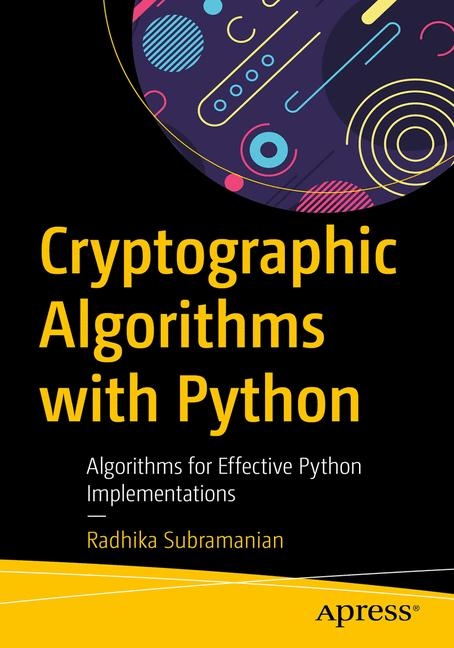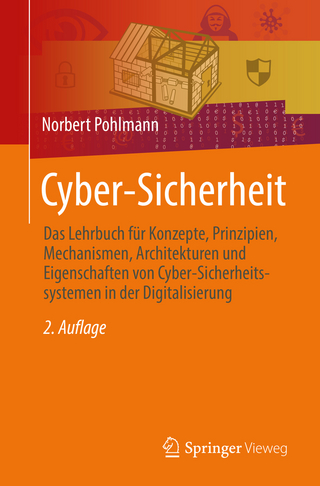
Cryptographic Algorithms with Python
Apress (Verlag)
978-1-4842-4083-0 (ISBN)
- Titel wird leider nicht erscheinen
- Artikel merken
Beginning with simple ciphers such as Reverse, ROT13, and XOR, you'll move towards classic ciphers such as Transposition and Vigenere. You will also gain an understanding of encrypting and decrypting files following Python standards. Further you will learn to encrypt your data with monoalphabetic ciphers such as Caesar and Affine. Finally, you will master the concepts of symmetric and public key cryptography by diving into the DES and RSA algorithms.
Each program featured in the book will be accompanied by the complete code with flow charts and a detailed explanation of the concepts.
What You Will Learn
Understand the concepts of cryptography and Python modules
Apply text-based encryption techniques
Encrypt and decrypt files based on Python standards
Work with monoalphabetic and polyalphabetic ciphers
Who This Book Is For
People new to cryptography with a basic knowledge of Python programming.
Radhika Subramanian holds more than 5 years of experience in Software Development and Content Writing. She is well versed with frameworks like Python, PHP and Java and regularly provides trainings on them. She is presently working with Educba and Eduonix as a Training Consultant since June 2016 and Academic writer with TutorialsPoint since Sept 2015.
Chapter 01: Cryptography 101All the basic concepts of cryptography with various algorithmsSections:History of CryptographySteganographyEvolutionUnderstanding modern and classic cryptographyTerminologies and FeaturesPrimitivesUse of Cryptography in Data ScienceWhy Python?
Chapter 02: Python RefresherUnderstanding the basics of Python language with functions, loops and conditional statements. It includes the demonstration of running python language.Sections:Understanding concepts (useful for this book)Conditional StatementsLooping structuresPackages
Chapter 03: Reversed Encryption using Reverse CipherUnderstanding Reverse cipher algorithm with flowchart and python code for implementing the same.Sections:Understanding Reverse CipherAlgorithmFlowchartPython Code with OutputDrawbacks (with hacking source code)
Chapter 04: Simple Encryption with ROT13 CipherUnderstanding concepts of ROT13 algorithm along with python code.Sections:Understanding ROT13 CipherAlgorithmFlowchartPython Code with OutputDrawbacks
Chapter 05: Addition with XOR CipherUnderstanding concepts of XOR algorithm along with python code.Sections:Understanding XOR CipherAlgorithmFlowchartPython Code with OutputDrawbacks
Chapter 06: Binary to ASCII using Base64 CipherUnderstanding concepts of Base64 with illustration and python code.Sections:Understanding Base64 encoding with illustrationAlgorithmFlowchartPython Code with OutputDrawbacks
Chapter 07: Single-alphabet Substitution with Caesar CipherUnderstanding Caesar cipher algorithm, flowchart and python code for same with encryption and decryption standardsSections:Understanding Caesar Cipher with illustrationAlgorithmFlowchartPython Code with OutputDrawbacks
Chapter 08: Plain-text Cryptography with Transposition CipherUnderstanding transposition cipher algorithm, flowchart and python code for same with encryption and decryption standardsSections:Understanding Transposition Cipher with illustrationAlgorithmFlowchartPython Code with OutputDrawbacks
Chapter 09: File Encryption and Decryption Understanding the procedure of how to encrypt and decrypt files following python standards.Sections:Importance of Encrypting filesPatternAlgorithmPython code for encryption and decryption
Chapter 10: In-build Python Modules Various inbuilt libraries which support cryptography tool implementation.Sections:Cryptography modulePasswords with FernetPycryptoGPGME BindingsSecure hashes and message digests
Chapter 11: Mono-alphabetic Substitution using Affine CipherUnderstanding affine cipher with algorithm, example and python code for demonstration.Sections:Understanding Multiplicative CipherUnderstanding Affine CipherAlgorithmFlowchartPython Code with OutputHacking Affine Cipher
Chapter 12: Alphabetic Encryption using Vignere CipherUnderstanding concepts of vignere cipher with python code implementationSections:Understanding Vignere CipherAlgorithmFlowchartPython Code with OutputHacking Vignere Cipher
Chapter 13: Substitution using Polyalphabetic CipherUnderstanding polyalphabetic cipher and its difference with Monoalphabetic cipher along with python code implementation.Sections:Understanding Polyalphabetic Cipher (one-time pad and two-time pad)AlgorithmFlowchartPython Code with OutputHacking one time pad cipherHacking two time pad cipher
Chapter 14: Symmetric-key CryptographyUnderstanding symmetric cryptography concepts, DES algorithm and implementation of DES algorithm along with hacking tricks.Sections:Symmetric cryptography conceptsExamplesDES AlgorithmFlowchartPython code for DES AlgorithmHacking DES Algorithm
Chapter 15: Public-key CryptographyUnderstanding concepts of public key cryptography, RSA algorithm and its implementation using Python code.Sections:Asymmetric cryptography (Public Key cryptography)ExamplesRSA AlgorithmFlowchartPython code for RSA AlgorithmHacking RSA Algorithm (Why it is so difficult to hack RSA algorithm)Alternatives
| Erscheint lt. Verlag | 28.3.2019 |
|---|---|
| Zusatzinfo | XV, 205 p. |
| Verlagsort | Berkley |
| Sprache | englisch |
| Maße | 155 x 235 mm |
| Themenwelt | Informatik ► Netzwerke ► Sicherheit / Firewall |
| Informatik ► Programmiersprachen / -werkzeuge ► Python | |
| Informatik ► Theorie / Studium ► Compilerbau | |
| Schlagworte | algorithms • ciphers • Coding • cryptography • modules • programming • Python • security |
| ISBN-10 | 1-4842-4083-9 / 1484240839 |
| ISBN-13 | 978-1-4842-4083-0 / 9781484240830 |
| Zustand | Neuware |
| Haben Sie eine Frage zum Produkt? |
aus dem Bereich


